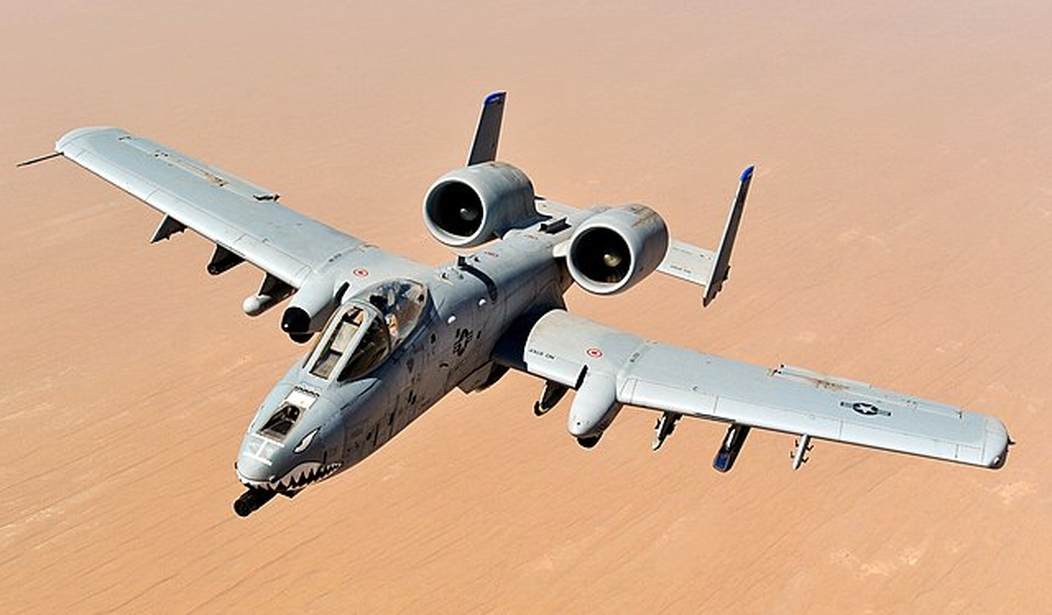Beloved as much by the grunts on the ground as the pilots who flew it, the A-10 ground attack jet is being retired after five decades of very loud and effective service. Air Force enthusiasts everywhere are going to miss that ugly S.O.B.
The Air Force announced plans last week to replace two of the last remaining A-10 squadrons with more modern F-16s and F-35s. “This is all in line with the service’s goal of divesting the last A-10s before the end of the decade, if not sooner,” according to Yahoo News. Air Force brass have been trying to retire the hog for years but Congress has kept telling them no. This new announcement indicates that the A-10 will not keep flying until the 2040s, after all.
But what a jet, even if it did have a face not even a mother could love.
With war in Vietnam raging, the time had come in the late ’60s for the Air Force to get serious about ground-attack missions — and finally develop a replacement for its fleet of (almost) WWII-vintage, prop-driven A-1 Skyraiders. It’s said that the best antitank weapon is another tank, and when it came to developing the A-10, the Air Force seems to have asked, “What if we took a tank and added wings and a couple of big-ass engines to it?”
Although the requirements for the Air Force’s new ground-attack jet were formulated during Vietnam, planners had a different enemy in mind: Soviet tanks. The goal then was to take a slow, heavily armored jet and give it a gun so big and powerful that it could rip open Russian armor like a tuna can.
Fairchild-Republic stepped up to meet the Air Force’s need, and the result was the A-10 Thunderbolt II. Neither sleek nor sexy, the Thunderbolt is usually called the Warthog or just the Hog. The whole jet was designed around the 30 mm GAU-8 Avenger rotary autocannon whose (airborne!) ammo magazine is the size of a Volkswagen Beetle. It’s capable of firing depleted uranium shells that tear through the thickest armor like a hot knife moving at 3,324 feet per second through melted butter.
That autocannon sounds like this:
Because the A-10’s job is to get in close, the pilot sits in a “bathtub” made out of titanium. During the Gulf War — when the Warthog first really captured the public’s imagination — I saw one jet on CNN that returned from a mission missing almost a third of one wing and probably half of the other. (I’ve searched for years for that clip but to no avail.) A fully-loaded Hog can carry an additional eight tons of various missiles and bombs.
The Hog’s engines are mounted high and to the rear with a slight tilt up towards the front. That’s to avoid sucking in debris on damaged airfields. Those Fairchild engineers really did think of everything.
The first development version of the Warthog flew in 1972, and it entered service in 1977. More than 700 were built, but only a few dozen are still in service. Although built in numbers to counter Soviet armor, our much-reduced force of A-10s found plenty of jobs that only they could do in Iraq and Afghanistan.
Honestly, the Air Force has never been that excited about ground attack. The “fighter mafia” that’s ruled the USAF in recent decades is much more interested in sleek and sexy air dominance fighters like the F-22 Raptor. There had been talk about trying to turn the surviving Warthog squadrons over to the Army but that just isn’t doable for a whole host of reasons — starting with the fact that the Army doesn’t have the experience, training, troops, or facilities to fly and maintain jets.
Related: M10 Booker: Meet the Not-Tank Named After Two Army Heroes
For what it’s worth, the Air Force has long argued that the F-35 Lightning II multirole stealth fighter is better prepared for ground attack in the 21st Century.
As a lifelong Warthog fan, it pains me to say this, but they’re probably right.
I wrote years and years ago at the original VodkaPundit.com that “stealth is the price of admission to the modern battlespace.” Non-stealth jets simply don’t stand a chance against the latest generation of air defense systems. Hell, they barely stand a chance even against a slightly older one.
The war in Ukraine has proven me (and many others) correct on that score. Despite having a much larger and more modern air force than Ukraine, Russia has been unable to achieve air superiority — even in the early months of the war, long before Western antiaircraft systems began service with Ukraine. Russia has no combat stealth aircraft in service, so even their most advanced Su-34 attack jets have been mostly limited to lobbing inaccurate dumb bombs from safe distances, outside the reach of Kyiv’s air defenses.
In a war with China or Russia, the A-10 likely wouldn’t survive. If — and this is a big if — there’s still a role for manned ground-attack jets, it’s with stealthy planes like the F-35 that are hard to see, harder to kill, and can fire a variety of long-range stand-off weapons.
But everybody who ever served alongside the A-10, saw one fly, or even just heard the sound of that glorious cannon, is going to miss it when the Hog is gone.










Join the conversation as a VIP Member